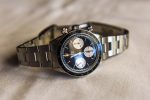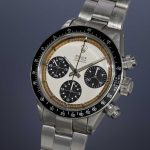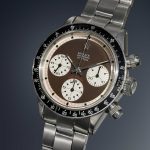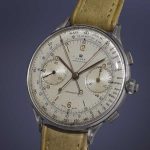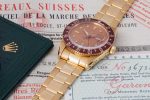Auctions
Aurel Bacs: Raising Auction House Roofs
Auctions
Aurel Bacs: Raising Auction House Roofs
Look back over the last 10 years at every record-breaking watch ever auctioned — from the CHF2.5 million paid for a Rolex split-seconds chronograph earlier this year, to the one million dollars paid for a RCO black-dial Paul Newman Daytona — and you’ll see Bacs at the auctioneer’s lectern charmingly pitting the biggest players in the room against each other, simultaneously speaking in English, Italian, French and German to the interested parties until the smoke clears, the hammer comes down and, once again, history is made.
Bacs’s status as a financial rainmaker is unparalleled. He grew Christie’s annual watch sales from USD8 million when he joined in 2003 to USD127 million when he left in 2013. Since then, he and wife Olivia have gone on to set up Bacs & Russo auctions with Phillips, and their performance has been transcendent. And now, as of May 2016, under his guidance, Phillips Watches has chalked up nearly $53M for their Spring 2016 auction season alone, making them the undisputed worldwide market leader.
But at the same time, it cannot be ignored that the biggest conversation being had around the table is centered on how the vintage-watch market is growing at an exponential rate, whilst first-hand-watch sales are faltering. We sat down with the enigmatic Bacs, to discuss the reasons behind the growth of vintage-watch sales in relation to ever-evolving cultural changes, and most importantly, to the realization that true rarity is primarily found in the world of vintage watches. Says Bacs, “If you look back at the history of wristwatches, I would say any complicated watch made before the mid-’80s was genuinely made in a truly artisanal way. Because this was before the introduction of things like computer programs, like CAD cam and numeric programing for machining. From the mid-’80s onwards, you have the transformation of complicated watchmaking into an industrial process, and as a result, the number of complicated watches increased dramatically.” Jean-Claude Biver, the Swiss watch industry’s greatest marketing Svengali, and a hugely passionate collector of vintage Patek Philippes, agrees completely. He explains, “Take for example, a Patek Philippe ref. 2499. How many of these are in existence, a few hundred? Let’s take away the ones that are lost or destroyed, or the ones no one wants to sell, and say at any given time, there are only 50 watches that might come onto the market in our lifetime. That’s why they cost 1.5 or 2 million dollars. Because they are genuinely rare.”
The amazing thing is Aurel Bacs probably knows where every one of those watches is. He explains, “The world of rare vintage watches is a very small and close-knit community. It is like the Rolex split-seconds chronograph we auctioned and that achieved a price of CHF2.5 million. There were only 12 of these ever made. Only eight of them have surfaced and I know where all of these eight are and what condition every one of these is in.” Watch Wei Koh’s interview with Mr. Biver where they discuss the vintage market.
But let’s step back for a second and ask why it is we’ve suddenly eschewed all things shiny and new, and why we’ve become enamored with all things vintage. It’s clear tastes have changed dramatically in the post financial crisis of 2008, turning us towards objects and styles that are more perennial.
Bacs feels, in the past decade, the first-hand-watch market has been flooded by brands keeping up with demand in particular from the Mainland Chinese market, and who can blame them? The art and craftsmanship of watchmaking in this post-industrial age is no longer at the core of the raison d’être of these brands. CEOs are expected by shareholders to multiply production and increase growth and dividends. As Bacs observes, the watch consumers’ universe has changed from having been a market of wealthy Europeans and Americans, to include 1.2 billion consumers from China, Southeast Asia, Central and South America, the younger start-up billionaire generation and more.
Despite economic woes, the world has never been richer. There are people who are more than willing to pay USD1,000,000 for a watch, and the watch manufacturers have delivered instead of risking their market share. But in so doing, they’ve killed the golden goose of exclusivity. Bacs believes this is where the problem lies: a man can no longer walk into a First Class lounge with his brand-new watch on display, without the risk of bumping into someone else with the same model on their wrist, except theirs is “most probably the limited edition with the green dial”. This is when, due to the flooded markets, Bacs says, “Luxury becomes relative luxury, becomes so-so luxury, becomes a commodity.”
The shift in focus from contemporary to pre-industrial, beautiful, complicated timepieces has had its share of opportunists. Auctioneers are deemed to be hyping up very old vintage Rolexes and Patek Philippes, and inventing creative sobriquets for any watch with signs of age. What, for Bacs, is a genuinely beautiful old watch? He explains, “It’s all about quality and that is the advice I give anyone looking for a vintage watch. It is better to buy the best-condition Jaeger-LeCoultre than the worst-condition Patek Philippe.” In educating consumers to pay attention to quality, Bacs has also been a revolutionary. He is also largely responsible for the change in the way we perceive quality. Says Wei Koh, “It’s like car collecting in the old days in America — you wanted a car that had a frame of restoration. Similarly, you wanted a watch that was polished and overhauled. Today, a car that is a survivor or barn find is far more valuable than a restored car. Similarly, Bacs has taught us that a watch in original condition, with an unpolished case, untouched dial, with everything original, is truly beautiful.” Says Bacs, “I’ve always admired the way things age. It’s like wine — nature and time create amazing changes that man can never replicate with his meddling.” Accordingly, Bacs has been one of the primary proponents of assigning value to signs of age in watches. The perfect examples are two screw-pusher ref. 6263 Paul Newman Daytonas sold at his START-STOP-RESET auction, earlier in May of 2016. The first was a two-color Panda dial, where the seconds track had turned a truly stunning amber hue and the other was a black RCO watch, where the black dial had turned a resplendent toffee color. Says Bacs, “But age has to occur naturally, and when it does, it makes those watches absolutely unique. Regarding those watches, you will never find another like either of those in the world.” Bacs communicated this to perfection, resulting in each achieving staggering prices: CHF929,000 for the two-color Panda dial and an unreal CHF1,985,000 for the black RCO.
Considering the term ‘tropical dial’, referring to a watch that shows this kind of aging (it specifically refers to a black dial that has turned brown as a result of UV light), has only emerged recently, one could query if Bacs invented it in order to assign greater value to watches exhibiting this patina. Says Bacs with a laugh, “That is very complimentary. Have I created the market? No, the market created itself. But have I provided the tools for the market? Yes. But the point is human beings are innately intelligent and innately responsive to beauty. If these types of watches were not genuinely beautiful, I doubt very much anyone would be interested in them.”
Vintage–Watch Prices — Still Room to Go?
2016 has been defining for the auctioning world with prices increasing across spheres, from a Basquiat being sold in New York for USD16,000,000 to a blue diamond ring going for USD60,000,000 and a Rolex for USD2,500,000. Bacs uses the comparison between these three to draw a conclusion as to their common denominator, to what justifies their ever-increasing value. He explains, “It cannot be age or material value; what they each share in common is the buyer’s heart — his capability to appreciate the finesse of the object.” Each piece has a high value as Bacs puts it, “in terms of rarity, complexity, craftsmanship, exclusivity and history”. It is in our culture, especially of late, to appreciate these virtues. And vintage watches — in particular, vintage Rolexes with their participation in all forms of sports and adventure — are ideally suited to embody these virtues. Says Bacs, “It is not possible to go back in time and make the split-seconds Rolex chronograph again; it cannot be taken back from the racing teams of the 1940s — it holds that history, that is how it plays on the heartstrings of the buyers.” The tastemakers of today are tapping into that cultural influence of appreciation of finesse, rarity and history, and through his knowledge and communicative ability, Bacs has buyers entranced.
But the end result of all of Bacs’s success is also that vintage watches have grown too expensive for even some of the most mature collectors. A prominent British collector recently stated, “I have been outpriced from the market.” He was speaking specifically of the Rolex market, having set himself a ceiling price on what he would pay for one and having seen markets soar above that price. This was not because of this collector being unable to afford the prices vintage Rolexes are now going for at auctions, nor because he feels disconnected or unable to trust the vintage-watch industry, but because he personally does not see the justification in paying such prices for a Rolex. Therefore, through this creation of an elite watch market, the outpricing of eligible prospective buyers begs the question of whether or not the vintage-watch market will reach a saturation point of its own.





